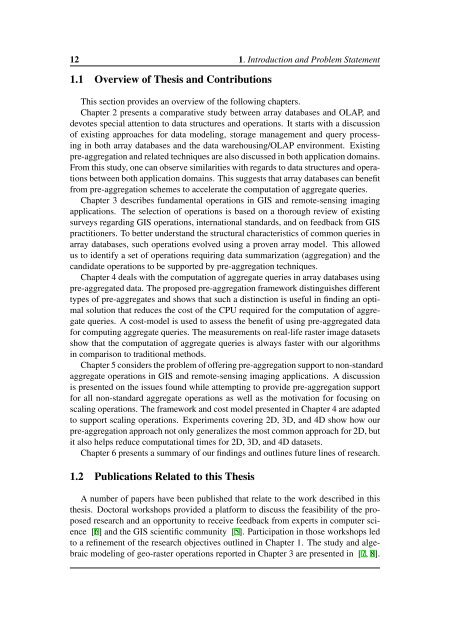Applying OLAP Pre-Aggregation Techniques to ... - Jacobs University
Applying OLAP Pre-Aggregation Techniques to ... - Jacobs University
Applying OLAP Pre-Aggregation Techniques to ... - Jacobs University
You also want an ePaper? Increase the reach of your titles
YUMPU automatically turns print PDFs into web optimized ePapers that Google loves.
12 1. Introduction and Problem Statement<br />
1.1 Overview of Thesis and Contributions<br />
This section provides an overview of the following chapters.<br />
Chapter 2 presents a comparative study between array databases and <strong>OLAP</strong>, and<br />
devotes special attention <strong>to</strong> data structures and operations. It starts with a discussion<br />
of existing approaches for data modeling, s<strong>to</strong>rage management and query processing<br />
in both array databases and the data warehousing/<strong>OLAP</strong> environment. Existing<br />
pre-aggregation and related techniques are also discussed in both application domains.<br />
From this study, one can observe similarities with regards <strong>to</strong> data structures and operations<br />
between both application domains. This suggests that array databases can benefit<br />
from pre-aggregation schemes <strong>to</strong> accelerate the computation of aggregate queries.<br />
Chapter 3 describes fundamental operations in GIS and remote-sensing imaging<br />
applications. The selection of operations is based on a thorough review of existing<br />
surveys regarding GIS operations, international standards, and on feedback from GIS<br />
practitioners. To better understand the structural characteristics of common queries in<br />
array databases, such operations evolved using a proven array model. This allowed<br />
us <strong>to</strong> identify a set of operations requiring data summarization (aggregation) and the<br />
candidate operations <strong>to</strong> be supported by pre-aggregation techniques.<br />
Chapter 4 deals with the computation of aggregate queries in array databases using<br />
pre-aggregated data. The proposed pre-aggregation framework distinguishes different<br />
types of pre-aggregates and shows that such a distinction is useful in finding an optimal<br />
solution that reduces the cost of the CPU required for the computation of aggregate<br />
queries. A cost-model is used <strong>to</strong> assess the benefit of using pre-aggregated data<br />
for computing aggregate queries. The measurements on real-life raster image datasets<br />
show that the computation of aggregate queries is always faster with our algorithms<br />
in comparison <strong>to</strong> traditional methods.<br />
Chapter 5 considers the problem of offering pre-aggregation support <strong>to</strong> non-standard<br />
aggregate operations in GIS and remote-sensing imaging applications. A discussion<br />
is presented on the issues found while attempting <strong>to</strong> provide pre-aggregation support<br />
for all non-standard aggregate operations as well as the motivation for focusing on<br />
scaling operations. The framework and cost model presented in Chapter 4 are adapted<br />
<strong>to</strong> support scaling operations. Experiments covering 2D, 3D, and 4D show how our<br />
pre-aggregation approach not only generalizes the most common approach for 2D, but<br />
it also helps reduce computational times for 2D, 3D, and 4D datasets.<br />
Chapter 6 presents a summary of our findings and outlines future lines of research.<br />
1.2 Publications Related <strong>to</strong> this Thesis<br />
A number of papers have been published that relate <strong>to</strong> the work described in this<br />
thesis. Doc<strong>to</strong>ral workshops provided a platform <strong>to</strong> discuss the feasibility of the proposed<br />
research and an opportunity <strong>to</strong> receive feedback from experts in computer science<br />
[6] and the GIS scientific community [5]. Participation in those workshops led<br />
<strong>to</strong> a refinement of the research objectives outlined in Chapter 1. The study and algebraic<br />
modeling of geo-raster operations reported in Chapter 3 are presented in [7, 8].
















